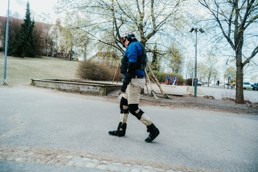Designing as the Motor of Change
-
Sist oppdatert
23. september 2022
-
Kategori
-
Tema
- Design
- Innovation
- Technology
The demand on academia is not just to understand and predict, but to improve and change. We are calling for designing as the motor of change.
KNOWLEDGE @ KRISTIANIA: Innovation
There was a time was when the academics lived and worked in an ivory tower and sought to understand the world. Questions that academia sought to find answers to were: What are we? What do we do? Why do we do what we do? Some ventured further and tried to predict what may happen when we do something. The gaining of wisdom for its own sake was valued, and even supported by society. The dominant paradigm was explanatory research.
Time though, does not stand still. And as Bob Dylan sang, “The Times They Are a-Changin'”. In a reversal of the Chinese curse, we are blessed to live in exciting times. The demands on academia is not just to understand and predict, but to improve and change. As Professor emeritus Geoff Walsham of Cambridge University put it: our mission is to make a better world.
Making a better world
Simply put, academia has a duty to contribute to society by working to make it better. This is especially vital for applied fields like Information Systems.
Certainly there are multiple paths to achieving this goal. In this piece, we focus on one path that is built on designing innovative Information Technology artifacts for improving society and help building a sustainable future.
Academic research can make significant contributions through at least two ways; 1) Partnering with practitioners through using proactive research methods and 2) Designing innovative artifacts.

Read also
Partnering with practitioners
The first way is through using proactive research methods, such as Design Science Research (DSR) that create new prescriptive knowledge through designing systems. This knowledge can be abstracted to more general class of the artifacts that are developed.
For example, design principles abstracted from a system based on Internet of Things (IoT) for agriculture can also be transferrable to other systems based on IoT. By focusing on real societal problems, academic research can contribute to society.
A specific Design Science Research method is Action Design Research (ADR) where an innovative artifact is designed in an organization (or networks of organizations) and is implemented and evaluated in one stage called Build, Intervention and Evaluation. Action Design Research is not possible without partnering with practitioners.
Designing innovative artifacts
The second way is designing innovative artifacts per se. An effective way is to encourage masters students to do so in their theses. Design oriented theses not only solve real problems faced by organizations, but also help organizations learn to deal with implementing organizational changes that always accompany technological interventions.
The two ways described above are intricately interlinked, but are not the same. Design refers to the application of synthetic and analytic processes to plan and create new objects, and is often thought of in the same breath as creativity or invention.
Design Science Research on the other hand is a research method with the primary aim of creating new knowledge such as methods and processes for developing arftifacts. It can indeed result in the production of beautiful, useful, and better artifacts.
The methods and traditions of Design Science Research are rooted in what the Nobel Laureate Herbert Simon calls the science of the artificial. It is fundamentally a problem solving research paradigm that studies IT artifacts that are created by humans.
Action-oriented as well as explanatory research
While we are calling for designing as the motor of change, it is not to denigrate the importance of research for understanding, explanining and predicting. There is a synergestic relationship between the action-oriented paradigm and the explanatory research paradigm.
Design is not what Professor Sandeep Purao of Bentley University, USA, insightfully terms “atheoretical tinkering”. The knowledge base that informs design comes from explanation research. The efficacy of the artifacts developed by design research is evaluated using methods of explanation research, and the developed knowledge contributes to the knowledge base.
We emphasize that design is not value-free. The axiology of designed artifacts need to be critically examined. Consider persuasive or nudging systems that are widely used in, for example, getting people to lead healthy lives or adopt environmentally-friendly habits. The same technology can be used to nudge people to be aggressive or to believe in conspiracy theories.
Ultimately though, societal impact, innovation and change comes through action. As Greta Thunberg tellingly sums up “hope does not come from words, hope only comes from action”.
References:
Hevner, S. T. March, J, Park and S. Ram, “Design Science in Information Systems Research”, MIS Quarterly, Vol. 28, No. 1, pp. 75-105, March 2004
M.K. Sein, O. Henfridsson, S. Purao, M. Rossi and R. Lindgren “Action Design Research”, MIS Quarterly, 35(1), 37-56, March 2011
Herbert A. Simon, Sciences of the Artificial, third edition, MIT Press, 1996)
About IDEAS Lab
- The mission of the IDEAS Lab (Innovation and Digitalization for Enterprises and Society Laboratory) at Kristiania University College is to increase the skills and awareness of students and the general public through offering courses in state-of-the-art technologies focusing on digitalization, sustainability, enterprise systems, and data analytics.
- The lab also provides an arena where business experts meet students and the public, and hold open seminars to discuss business and technology related issues, projects, and debates. The Lab provides free certification courses to students and the public, and provides free exams to students, and vastly discounted exams to the public with a symbolic fee.
- Examples of topic areas that the lab’s affiliated researchers conduct research on illustrate how cutting-edge technology is being explored to address important societal issues that is relevant for practice. One is Gamification: technology developed on the concept of games which can be applied to learning and training contexts. Another area is Persuasive technologies where researchers examine how technologies such as mixed reality (integrating types of virtual technology) can be leveraged to make individuals make healthy or sustainable choices.
- Lab Director: Professor Moutaz Haddara
- Web page: www.ideaslab.no
We would love hearing from you:
Send your comments and questions regarding this article by e-mail to kunnskap@kristiania.no.
N

In the future, being around other people may prolong the lifetime of your smartphone’s battery
Proximity to others might have some surprising benefits.Les mer
Artificial intelligence ensures a more defensive cyber security on the Internet of Things
Artificial intelligence (AI) can be a very useful tool to learn the behaviors of cyber-attacks, writes Guru Prasad Bhandari.Les mer
N2

How blockchain technology can enhance trust in social business
Blockchain technology can be applied to enhance transparency and accountability in social business operations and thus lead to trust.Les mer
Predicting your next move
We can address societal challenges and gain valuable business insights by predicting people's next move.Les mer


